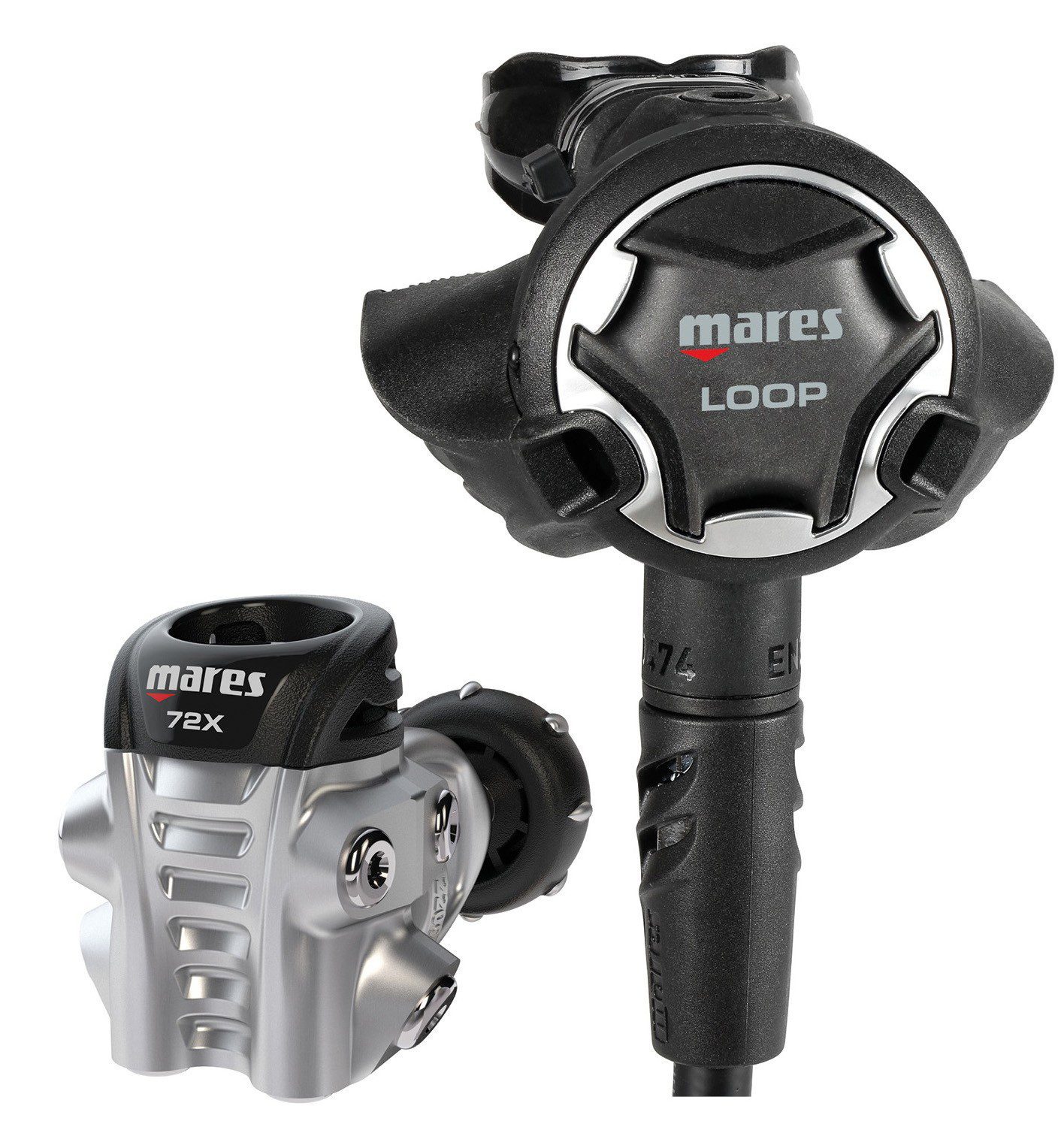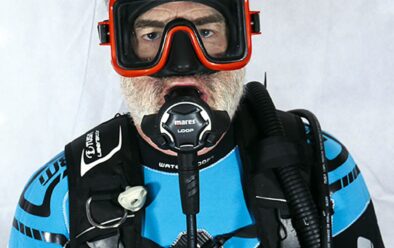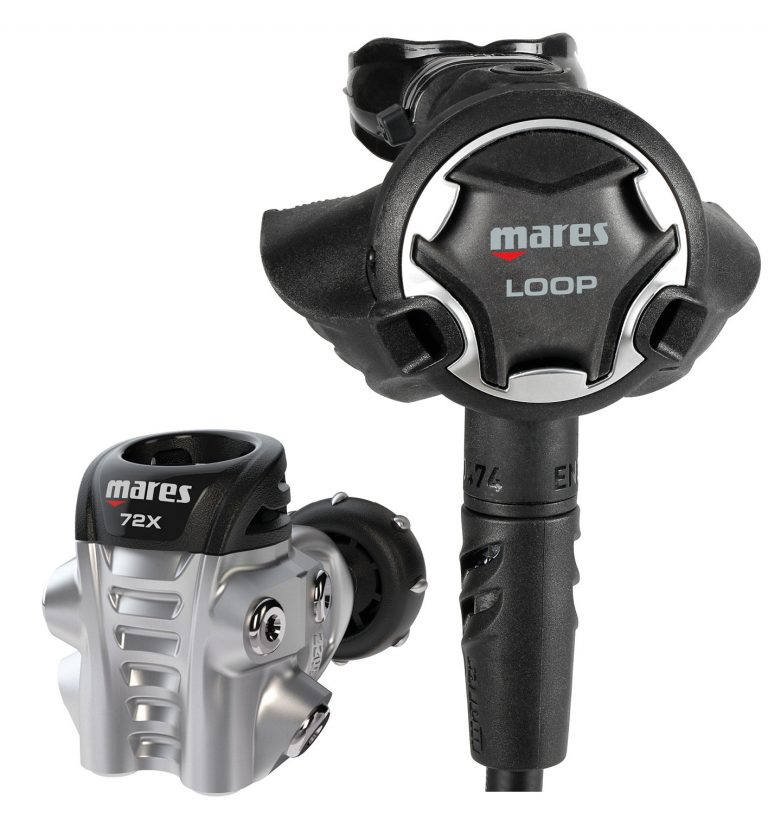Mares 72X / Loop

Appeared in DIVER June 2019
MARES HAS NOT HELD BACK in submitting budget kit for test recently, and in doing so shows commendable confidence in even its entry-level ranges.
When it comes to regulators Mares, founded in 1949, draws on long experience. In the 1970s it collaborated with US manufacturer Voit, which developed the patented VAD venturi system used in Mares second stages. It later absorbed Dacor, another US scuba giant responsible for some striking regulator breakthroughs.
Having been highly impressed by Mares’ most expensive model, the 82X first stage paired with the Epic Adj second stage, I was keen to try out the less expensive 72X combined with the unconventional under-arm Loop.
First Stage
Mares has mostly committed to balanced-diaphragm operated first stages, believing they offer higher performance than balanced-piston models, something makers of piston regulators will no doubt contest.
The 72X has one high-pressure port for pressure gauges or transmitters on each side. It then has no fewer than eight mp outlets.
Most recreational divers will need four at most – one for their primary second stage, another for an octopus and possibly two more to run BC and drysuit direct feeds. The idea of having so many mp ports is simply to provide plenty of choice for configuring your hose routeing.
Four face straight down when the first stage is “upright”, while the rest lead off from the sides.

Mares says that each port provides very high flow-rates, allowing a lot of gas to be supplied to more than one hose simultaneously.
Simultaneous demand for such high flow to multiple ports could occur during emergency sharing with another diver using your safe second, especially if you’re trying to inflate your BC at the same time.
Regulator designers commonly use a dedicated port to serve the primary second stage, to ensure that it gets the lion’s share of air when demand is high, because some first stages couldn’t supply equally large volumes of gas to all the ports in unison.
In such cases, priority is given to supplying the port from which you’re breathing.
A downside to a priority port is that it limits options for configuring your hoses. This has become more of a problem with the emerging popularity of technical diving, including sidemount. By providing so many choices of high-flow mp ports, the 72X is meant to eliminate compromises in laying out your whips.
It also facilitates a progression from rec to tech without buying a new first stage.
Mares uses a system it calls DFC (Dynamic Flow Control) to boost gas flow through the ports. This harnesses the venturi effect, with air routed to cause a vacuum that pulls other air after it. Reducing pressure drops in the first stage as you inhale is meant to make breathing easier.
The 72X is 40% nitrox-compatible out of the box. It is CE-rated for diving down to 4°C, though CE testing imposes fairly short periods for this freeze test. For colder conditions and longer dives, a choice of two isolating caps can be fitted over the main spring, which is otherwise open to the water.
It is possible, especially if ice-diving, for icing to occur here and block the operation of the spring. One coldwater kit surrounds the spring with silicone, which resists freezing; the other uses air, an excellent insulator.
The 72X is available in yoke or 300-bar DIN fitting. I prefer DIN – along with allowing use of high-pressure cylinders, it’s much harder for the captive O-ring to blow or for the first stage to be dislodged by impact.
DIN fittings can be difficult to remove from a tank with wet hands, but the Mares handwheel solves this. The 72X tank connection is protected by Mares Auto Sealing Technology, which closes off the inlet when it’s not pressurised. If you drop the 72X into a dip tank without its dust-cap, it shouldn’t leak water into the mechanism.
Second Stage
There’s a small wreck off Gibraltar that has an engine-room ideal for underwater photography. The light streams in from overhead and falls on the motor blocks and rungs of a crew-ladder.
Just behind is a small cabin, entered through a narrow doorway and, in its ceiling, a tight hatchway leads back into open water.
Most of my regulator hoses are routed to avoid catching in confined spaces. I’m nowhere near as fastidious about this as tekkies like Mike Ward, but it works for me – except for the second-stage hose feeding me air.
This hose must be long enough to allow me to move my head from side to side comfortably and, by tradition as much as for any other reason, it comes over my shoulder. This creates a loop, and that loop seems to have a magnetic attraction for fouling.
In Gib, it tends to catch just as you put your head through the door-frame, so it’s caught up behind you, where you can’t see it. Now you’re stuck in a barge 15m down. That’s when it finally dawned on me to tuck the hose under my arm.
The Loop does away with over-the-shoulder routeing and leads the hose under your arm from the get-go. This isn’t new – I have a 50-year-old Australian SeeBee that does the same, and Sherwood has offered one since the early 1990s.
Under-arm hoses are used by AGA on its professional sets for SAR and police divers, too, but the concept has never really caught on among leisure-divers.
Perhaps the Loop seeks to solve a problem that doesn’t exist for many divers, but for those who do dive into tight gaps, such as in wrecks, it merits attention. It’s possible to run virtually any second stage under your arm by adding a swivel, but these can badly restrict air flow. The Loop is designed for the job.
In Use
I chose to run the Loop primary and octopus from the ports on the end of the first stage. I ran the primary under my right arm and the octopus under my left.
The technopolymer Loop is lightweight and very comfortable on long dives. It isn’t pneumatically balanced, a feature that reduces cracking effort, so you do have to inhale a bit harder to get the air flowing, compared to using a balanced second stage like the Epic Adj. Once you crack the valve, however, the VAD venturi takes over and breathing is easy and smooth.

There is no user adjustable-control for tweaking the cracking effort, or a pre-dive switch to shut off the venturi to prevent freeflows when the reg is out of your mouth. So what? When used wrongly, such devices tend to cause CO2 headaches!
Technopolymer is a poor conductor of heat, compared to the metal second stages Mares also offers. My understanding is that the Loop’s coldwater performance owes much to the VAD.
Venturis direct air into the second stage to create a vacuum that helps keep the diaphragm depressed, in turn keeping the valve open for you with very little lung effort. In most second stages the air expands rapidly as it exits the inlet valve, causing a temperature drop at the point where the valve is most vulnerable to icing.
VAD defers this expansion and super-cooling, so that it takes place inside a tube further from the inlet valve.
The purge is easily pressed with a gloved hand and the exhaust-T does a fair job of diverting your bubbles from your field of view. The Loop is low-profile enough for photographers to get their eye up against their viewfinder without the second stage getting in the way.
The primary hose is quite long at 100cm, compared to 75cm for an over-shoulder Mares primary. It’s about the same length as a standard Mares safe-second hose, including that of the Loop octopus, so if you don’t secure it, it will swing around a bit (in my case by my knees, as I’m 5ft 8in).

So walking around, climbing ladders and so on could cause it to snag or rebound and whack a guy in the vulnerables.
I solved this by pushing the mouthpiece through a shoulder-strap D-ring, and secured the Loop octopus the same way. It comes with an anchor-shaped retainer that pushes into the mouthpiece stem, and often came away from this holder, but the D-ring trick always worked.
My method doesn’t prevent sand getting into the octopus, however – I’d prefer an octopus retainer that slips over the entire mouthpiece.
Recovery & Donation
I was curious to see how easy regulator recovery would be with the Loop. Some divers prefer to reach back to the first stage, locating the hose there before tracing it back to the mouthpiece, but I found the hose hard to follow where it lay alongside the BC and tank.
The arm-sweep technique, which I tried repeatedly, was fine every time.
The 360° swivel hose enters at the bottom of the Loop. Some divers I showed it to who plan to donate their primary and keep their back-up on a neck loop around their throat thought the depth would get in the way of their chin.
I respect their view, but I keep my safe second clipped to my BC, so it’s not a concern for me. Because of the Loop’s underslung swivel, it can be turned to face in towards the owner or out to face an out-of-air diver, so it simplifies sharing.
There’s endless debate about whether a conventional octopus should lead from left or right. I tend to run mine from the right, so that the mouthpiece faces me. I figure an OOA diver
is as likely to snatch the one from my mouth as not, so I want to be able to reach for my own secondary and use it without kinking the hose.
I also often dive independent singles, so having two regs coming over the right is how I’ve come to expect my regs to be laid out. And I assume I’ll be making a direct face-to-face ascent if I do have to share. In Gib, however, a lot of the diving is from beaches and many local divers prefer to donate from the left. This, they reason, makes it easier for donor and recipient to swim parallel on the return to shore.
The Loop mouthpiece always faces the diver needing it, regardless of whether face-to-face or side-by-side, so there is no left/right argument to be had.
Normally, I test how easy a second stage is to clear inverted, because in the heat of a sharing emergency that’s how someone might put it into their mouth. I didn’t do this with the Loop because it’s so hard to envisage that happening.
Under Pressure
Nick Balban of Gibraltar SAC and I took the 72X with the Loop octopus to 32m on a 7-litre / 300-bar stage cylinder to assess breathing performance in a sharing situation.
Under the EN250A standard a regulator should be able to provide 125 litres of gas per minute at the surface (so four times that at 30m). It’s not possible to assess the subtleties of work of breathing as scientifically as an instrumented machine does, but in a manned dive we can at least try to outbreathe the test regulator.
We had already tested the Loop octopus on the Mares 82X first stage at 52m, way in excess of the CE standard, and been impressed. On this dive we finned as hard as we could against the shotline anchor and burned through around 1000 litres in about two minutes. All the air we demanded was supplied easily enough.
CO2 build-up means that you can work that hard only for a short period, but it’s a valid test in my view because in a sharing situation huge volumes of air could be demanded, however briefly. At recreational depths, I don’t think you could “beat the lung”, as outbreathing a regulator is termed, while sharing with the Mares.
Conclusion
The 72X is a very good performer. The huge number of ports is a simple but very effective concept, and really does help to optimise hose-routeing, reducing binding, snarls and other conflicts common to configuring regulators.
I quickly became unaware of the Loop hose altogether. It’s a commendable system and, perhaps, should have been the standard configuration for recreational divers from the start, but I suspect that this superior snag-free hose-routeing will be slow to catch on.
The Loop offers a good breathe, though the difference in ease of cracking effort between it and the pneumatically balanced Ultra Adj is apparent and to be expected, given the price difference. But if you want a budget recreational or stage regulator, the 72X and Loop combo is a winner. Recommended.
Specs
TESTER> Steve Warren
PRICE> £311, Octopus £88, CWD Dry Kit £67, Twin Balanced-Piston Dry Kit £80
FIRST STAGE> Balanced diaphragm with DFC
SECOND STAGE> Downstream with VAD
PORTS> 8mp, 2hp
WEIGHT> 1082g DIN, 1256g Yoke
CONTACT> mares.com
DIVER GUIDE> 9/10

